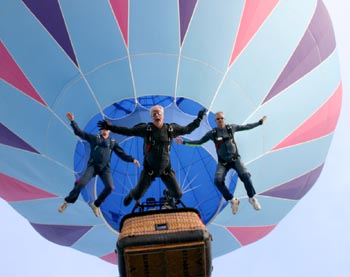
Brian LeSchander is not someone who keeps his feet firmly planted on the ground. He is, however, a man who lives life to the fullest and has done so since he started skydiving at age 15. Now, at age 50, LeSchander has completed 3,000 jumps - and he doesn't plan on stopping there. For his landmark jump, LeSchander decided to jump from a balloon rather than a plane. "When you jump from a balloon you are going into a no wind environment, unlike jumping from a plane which is in constant motion," he said. "With a balloon you are stepping off into 'naked' air. It's hard to do and not tumble." The peace and quiet of it was what amazed him the most. "We jumped from 5,000 feet into silent air and did a 15-second freefall before deploying the parachutes." LeSchander credits his friend, Bill Farress, with turning him on to the sport of sky diving when he was a teenager. "Bill was like a big brother to me," he said. That "big brother" came home from Viet Nam but still had to make military jumps when he got home. "Jumping, or skydiving, wasn't something I had ever really dreamed of but the next thing you knew, I was standing out on the wheel of an airplane preparing to freefall." When LeSchander first started out there was a six hour training. "It was a pretty intense jump from 3,000 feet." He said many people do their first jump in tandem with a master instructor who helps the novice learn to freefall. "Learning to freefall through space at 120 miles per hour isn't something you want to do alone for your first time." Training in the art of skydiving is very important, LeSchander stresses. When learning to skydive, students typically jump with one or two jump masters who help keep them stable and go through drills in a controlled environment. Now with 3,000 jumps under his (parachute) belt, LeSchander needs no assistance but does do many jumps with friends. "Several of us lease an airplane in Niagara Falls for our jumps. It's a Dehavilland Twin Otter 650 horse power twin engine plane and it carries them to their jump altitude of 14,000. Jumping from 14,000 feet means a skydiver can enjoy the view on the way down for about 75 seconds before having to pull the ripcord. "The real view is on the way up in the plane," LeSchander said. "I've seen some beautiful sunsets and the clouds are just remarkable. I'm a lucky guy to be able to do all of this." Even after all this time and with all of the jumps he has completed, LeSchander said recent jumps are just as thrilling as jumping was the first time. "After so many jumps it is an art form to get to the upper levels," he said. "Also, the training and camaraderie that goes into jumping are the best parts." The intense training is what keeps LeSchander and 48 other jumpers as the world record holders in a night, two-point 49-way jump formation. The maneuver is performed under the cover of darkness and involves choreographing 40 people, in mid-air, into a formation. Not an easy task, according to LeSchander. But, ever the thrill-seeker, LeSchander will be attempting to set another world record nighttime parachute maneuver involving parachutists over age 40, building a 16-man formation. "Formation skydiving is what I love," he said. The jump will take place September 25. In addition to completing his landmark 3,000 jump, LeSchander celebrated landmark birthdays, his 30 and 40 with as many jumps on that day. While LeSchander said he has had a couple of scary moments in his long jump career, proper training is what made those moments turn out for the best. "Like anything you do, there will be some frightening times, but if you have trained and know what you're doing, it all works out." In his off time from skydiving, LeSchander, of Spencerport, is a contractor/carpenter. "Being on a roof, 40 feet above the ground is much scarier than freefalling from 14,000 feet," he said. |
